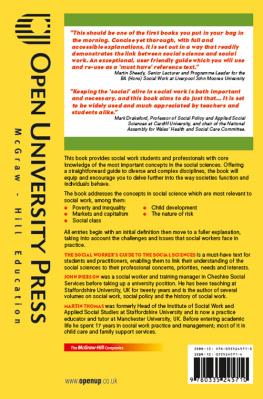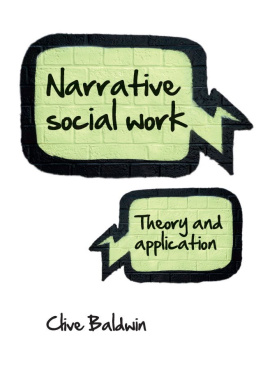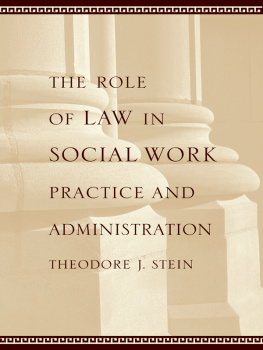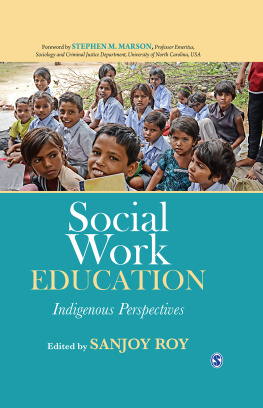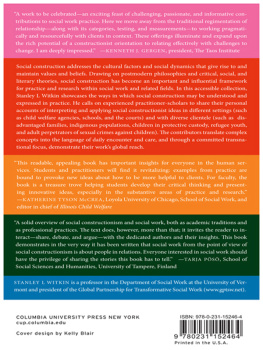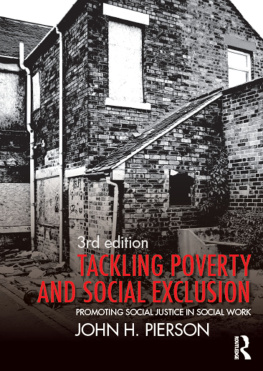
The Social Workers Guide to the Social Sciences
The Key Concepts
The Social Workers Guide to the Social Sciences
The Key Concepts
John Pierson and Martin Thomas

Open University Press
McGraw-Hill Education
McGraw-Hill House
Shoppenhangers Road
Maidenhead
Berkshire
England
SL6 2QL
email:
world wide web: www.openup.co.uk
and Two Penn Plaza, New York, NY 10121-2289, USA
First published 2013
Copyright John Pierson and Martin Thomas 2013
All rights reserved. Except for the quotation of short passages for the purposes of criticism and review, no part of this publication may be reproduced, stored in a retrieval system, or transmitted, in any form or by any means, electronic, mechanical, photocopying, recording or otherwise, without the prior written permission of the publisher or a licence from the Copyright Licensing Agency Limited. Details of such licences (for reprographic reproduction) may be obtained from the Copyright Licensing Agency Ltd of Saffron House, 610 Kirby Street, London, EC1N 8TS.
A catalogue record of this book is available from the British Library
ISBN-13: 978-0-335-24571-0
ISBN-10: 0-335-24571-4
eISBN: 978-0-335-24572-7
Library of Congress Cataloging-in-Publication Data
CIP data applied for
Typeset by Aptara Inc.
Printed in Great Britain by CPI Antony Rowe, Chippenham, Wiltshire.
Fictitious names of companies, products, people, characters and/or data that may be used herein (in case studies or in examples) are not intended to represent any real individual, company, product or event.

Dedication
We would like to dedicate this volume to our grandchildren.
For Martin: Amarachika, Georgia, and Benjamin
For John: Silas, Marguerite and Theodo
Praise for this book
This should be one of the first books you put in your bag in the morning. It explains, in clear language, the most important social science concepts, ideas and theories which social workers use in their practice. Students will find this an invaluable aid to understanding. Concise yet thorough, with full and accessible explanations, it is set out in a way that readily demonstrates the link between social science and social work. An exceptional, user friendly guide which you will use and re-use as a must have reference text.
Martin Sheedy, Senior Lecturer and Programme Leader for the BA (Hons) Social Work at Liverpool John Moores University
Keeping the social alive in social work is both important and necessary, and this book aims to do just that. It provides students with an accessible and easy-to-use account of key ideas and concepts which shape the lives of social work users and those who work with them. It is set to be widely used and much appreciated by teachers and students alike.
Mark Drakeford, Professor of Social Policy and Applied Social Sciences at Cardiff University, and chair of the National Assembly for Wales Health and Social Care Committee.
Acknowledgements
We wish to express our gratitude to David Jary, former dean of social sciences at Staffordshire University and esteemed colleague and friend, whose work and vision of higher education has always been an inspiration to us.
John Pierson would like to thank Claire Stockdale, Colleen Cloete and Linda Houlton of the Chester and Cheshire West Library based at the Bishop Heber High School for all their work in tracking down and keeping track of the many volumes I requested of them over the last year during the writing of this book. He would also like to thank Miriam Sharp Pierson for her preparation of the figures used in the volume.
Introduction
For over a century the social sciences have been central to social work thinking and practice because they address the big questions the relationship between society and the individual, why and how society changes, why individuals behave as they do. Social work and the social sciences developed together at roughly the same point in the late nineteenth century. The founding of the London School of Economics in 1895, for the betterment of society, can be taken as the pivotal moment: it was the first university in Britain to teach sociology and the first to offer social work training when it linked up with the Charity Organization Society, one of the founders of casework, in the late 1890s.
From that point on the social sciences have provided the core of the curriculum in social work education. Yet today students undertaking qualifying programmes in social work and social care do not currently have access to a reference book that enables them to make sense of the terms, concepts, theories and discourses central to social sciences. Neither do they have to hand a volume that is a ready reference for research methods and epistemological debates specifically devised to address their concerns, priorities, needs and interests in relation to the social sciences.
This book addresses that deficit. It is essentially a study aid and primer providing an understanding of the social sciences for social workers, a guide through a diverse and complex ensemble of disciplines. Throughout, we have selected those concepts in social sciences that are most relevant to social work. Some of the subject matter we cover in our entries are:
- adult and child behaviour;
- bureaucracy and organization;
- place, community and neighbourhood;
- race, outsiders and ghettos;
- social exclusion, stigma and oppression;
- gender and sexual preference;
- poverty and inequality;
- the nature of risk;
- markets and capitalism;
- co-operation, partnership and collective action;
- statistical analysis and research methods.
Our book is a companion to the Dictionary of Social Work . The entries in the Dictionary were developed from the everyday concerns and working terminology of the social worker, offering orientation within the social work terminological universe, so to speak. This volume offers social work students and practitioners a briefing on the key concepts developed by social scientists outside social work but which students and practitioners not only draw on for their everyday work but use in their theories and conceptualization of social problems. The volume in effect should be regarded as an encyclopedia of the social sciences.
The key concepts are arranged alphabetically. The objective of each is to explain the concept in everyday language and point out its implications for social work. Each begins with an initial definition and then moves to a fuller explanation with references and suggestions for further reading where appropriate. The longer concepts in particular are written against a backdrop of what social workers do and the contexts of problems, methods and issues they encounter in their practice. Where we use terminology developed within the social sciences that may be unfamiliar to social workers, we have taken care to explain what those terms mean in everyday language.
Many entries are part of larger, ongoing debates, and are continued in related entries. The links to these other entries are identified in bold in the text. By following the links across the volume the reader can explore the major themes and questions that dominate both social work and the social sciences. Is human nature basically self-interested or willing to act for the well-being of others? Are we rational beings? Are people poor because of their personal habits or because of the social and economic conditions in which they live? Does society function as a system? What is the nature of co-operation and collective action? How much science is in social science? These and many others are the kinds of big question that this volume addresses. As the reader will discover, the book provides a range of explanations and presents different sides to specific debates, drawing on examples and approaches that we have developed over years of teaching. Ultimately, though, it is up to the readers to work through these and reach their own conclusions.
Next page
